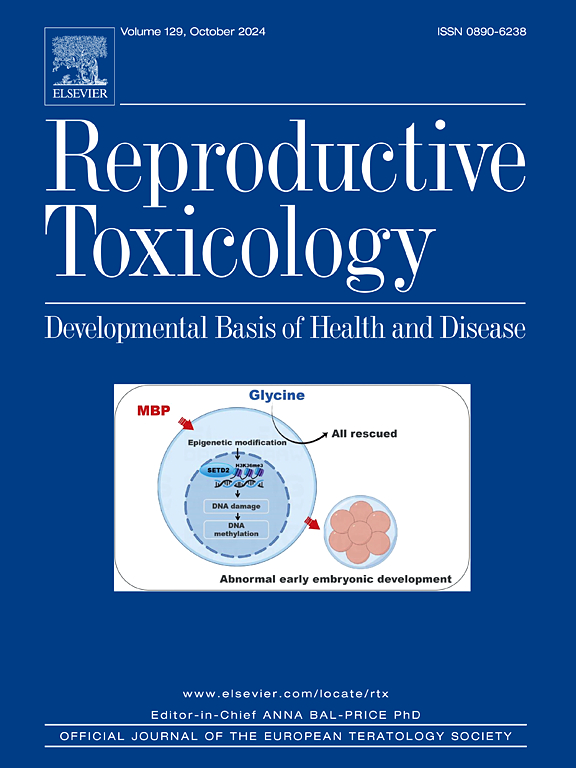The effects of exposure to microplastics on female reproductive health and pregnancy outcomes: A systematic review and meta-analysis
IF 2.8
4区 医学
Q2 REPRODUCTIVE BIOLOGY
引用次数: 0
Abstract
Microplastic pollution is one of the most important challenges to public health. The current study aimed to assess the impact of microplastic accumulation on female reproductive health and pregnancy outcomes. A comprehensive search was conducted in databases, including ISI Web of Science, PubMed, Scopus, and Google Scholar, to evaluate the effects of microplastic contamination on reproductive health and fetal outcomes. Thirteen studies met our criteria. Microplastic pollution was found in samples of placenta, meconium, amniotic fluid, and feces. In total, 10 polymers were identified, among which polystyrene, polyurethane, and polyamide polymers were the most abundant. The average size of the microplastics was 2.1–100 micrometers. The contamination rate with microplastics was measured at about an event rate of 87 % (95 % CI: 80.0–91.2). It was found that microplastic content in human reproductive tissue has nothing to do with the mode of delivery. Also, the results showed that consuming food in plastic containers increased the chance of contamination with microplastics in pregnant women (95 % CI: 1.32–21.9; OR: 5.39). The clinical elevation of microplastic accumulation with adverse pregnancy outcomes has shown a significant correlation between microplastic content in the placenta and gestational age (95 % CI: 0.03–0.22; OR: 0.89). In addition, microplastic pollution in the placenta significantly increases the risk of intrauterine growth restriction (IUGR) (95 % CI: 2.07–8.06; OR: 5.06). Microplastics may be a risk factor that contributes to human reproductive health issues and pregnancy-related outcomes; further large-scale investigations are needed to confirm the current findings.
接触微塑料对女性生殖健康和妊娠结局的影响:系统综述和荟萃分析
微塑料污染是对公众健康最重要的挑战之一。目前的研究旨在评估微塑料积累对女性生殖健康和妊娠结局的影响。在包括ISI Web of Science、PubMed、Scopus和谷歌Scholar在内的数据库中进行了全面的搜索,以评估微塑料污染对生殖健康和胎儿结局的影响。13项研究符合我们的标准。在胎盘、胎粪、羊水和粪便样本中发现了微塑料污染。共鉴定出10种聚合物,其中聚苯乙烯、聚氨酯和聚酰胺聚合物数量最多。微塑料的平均尺寸为2.1-100微米。微塑料污染率约为87 %(95 % CI: 80.0-91.2)。研究发现,人体生殖组织中的微塑料含量与分娩方式无关。此外,结果表明,食用塑料容器中的食物增加了孕妇被微塑料污染的机会(95 % CI: 1.32-21.9;或者:5.39)。临床微塑料积累升高与不良妊娠结局显示胎盘微塑料含量与胎龄显著相关(95 % CI: 0.03-0.22;或者:0.89)。此外,胎盘中微塑料污染显著增加了宫内生长受限(IUGR)的风险(95 % CI: 2.07-8.06;或者:5.06)。微塑料可能是导致人类生殖健康问题和妊娠相关结果的风险因素;需要进一步的大规模调查来证实目前的发现。
本文章由计算机程序翻译,如有差异,请以英文原文为准。
求助全文
约1分钟内获得全文
求助全文
来源期刊

Reproductive toxicology
生物-毒理学
CiteScore
6.50
自引率
3.00%
发文量
131
审稿时长
45 days
期刊介绍:
Drawing from a large number of disciplines, Reproductive Toxicology publishes timely, original research on the influence of chemical and physical agents on reproduction. Written by and for obstetricians, pediatricians, embryologists, teratologists, geneticists, toxicologists, andrologists, and others interested in detecting potential reproductive hazards, the journal is a forum for communication among researchers and practitioners. Articles focus on the application of in vitro, animal and clinical research to the practice of clinical medicine.
All aspects of reproduction are within the scope of Reproductive Toxicology, including the formation and maturation of male and female gametes, sexual function, the events surrounding the fusion of gametes and the development of the fertilized ovum, nourishment and transport of the conceptus within the genital tract, implantation, embryogenesis, intrauterine growth, placentation and placental function, parturition, lactation and neonatal survival. Adverse reproductive effects in males will be considered as significant as adverse effects occurring in females. To provide a balanced presentation of approaches, equal emphasis will be given to clinical and animal or in vitro work. Typical end points that will be studied by contributors include infertility, sexual dysfunction, spontaneous abortion, malformations, abnormal histogenesis, stillbirth, intrauterine growth retardation, prematurity, behavioral abnormalities, and perinatal mortality.
 求助内容:
求助内容: 应助结果提醒方式:
应助结果提醒方式:


